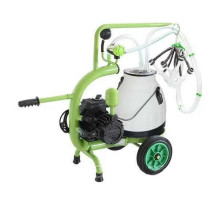
Milking machines for cows, goats and sheep: Buy in Ukraine with delivery
Tired of tedious manual milking that takes a lot of time and effort? Modern milking machines are not just equipment, but your investment in the productivity, efficiency and health of your livestock. Our milking systems simplify the process of milking cows, goats and sheep, making it fast, comfortable and safe. Thanks to advanced technologies, you not only save a lot of time, but also prevent the risk of mastitis, increasing milk yield. Place an order for a milking machine with delivery throughout Ukraine and feel the difference today!
---Milking machines: price, quality and efficiency for your farm
A properly selected milking machine is the key to a successful dairy farm. We offer a wide range of models that meet the highest safety and quality standards. In our range you will find equipment that will meet the needs of both a small farm and a medium-sized farm. We have made sure that you can choose the optimal device, taking into account the specifics of your animals and the volume of work. Thanks to our milking machines, the milking process will become easy, and milk yields will be stable and high.
---Key features and benefits of our milking systems
We offer a wide range of milking systems with different technical characteristics, making them ideal for any need. Choose what suits you:
- ✅ Pump type: We have models with both an oil pump , which provides quiet and durable operation, and a dry pump , which is easy to maintain and resistant to low temperatures.
- ✅ Bucket material: You can choose a lightweight and practical aluminum bucket or a durable and hygienic stainless steel bucket that is resistant to corrosion.
- ✅ Pulsation function: Some models are equipped with this important function that simulates manual milking, making the process as comfortable as possible for the animal and preventing stress.
- ✅ Versatility: Our catalog features models for milking cows, goats and sheep , making them a universal solution for mixed farms.
Milking machine: buy with warranty and delivery in Ukraine
We understand that purchasing equipment is a serious investment. Therefore, we guarantee the high quality of each milking machine and provide an official warranty from the manufacturer. Our devices meet all European safety and environmental standards. Placing an order will take only a few minutes, and our delivery service will promptly deliver your equipment to any point in Ukraine. Trust the professionals and optimize the operation of your dairy farm without unnecessary effort!
---Choose and order your ideal milking machine now!
Don't waste time on tedious manual labor. Choose reliability, efficiency, and comfort with modern milking machines. Buying a milking machine in Ukraine has never been easier. Check out our range, compare prices and specifications, and make a profitable purchase. Let technology work for you, increasing profits and simplifying daily work. Order now!






















